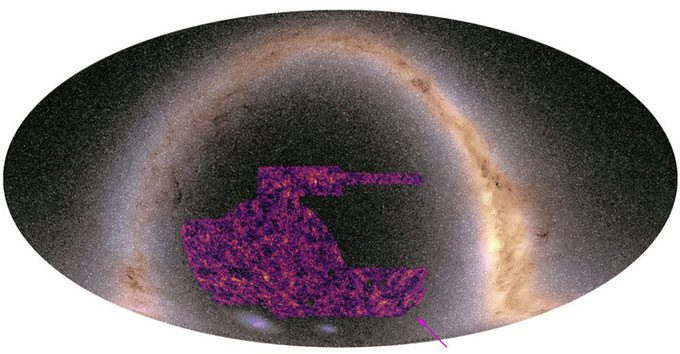A New Map of Dark Matter Created from Observations of 226 Million Galaxies, Processed Using AI and High-Performance Computing.
Astronomers have utilized the largest dataset of galaxies, covering nearly 1/8 of the visible sky, to create precise measurements of the composition and evolution of the universe, IFL Science reported on May 29. This data was gathered during the first three years of the Dark Energy Survey (DES)—a program involving over 400 scientists from 25 research institutions across 7 countries.

The DES dark matter map (in purple) overlaying an image of the Milky Way. (Photo: DES).
The research team used observational images of more than 226 million galaxies to create the largest map of dark matter, spanning over 7 billion light-years. The map illustrates the Standard Model of Cosmology, the primary hypothesis underpinning human understanding of the universe, which remains the best model to date.
According to the Standard Model, the universe consists of three main components: ordinary matter—what makes up humans, dark matter—an invisible substance that permeates everywhere and is five times heavier than ordinary matter, and dark energy—the most abundant component, causing the universe to expand at an accelerating rate.
“This is truly the most advanced analysis, requiring artificial intelligence (AI), high-performance computing, and the most talented young scientists,” said Scott Dodelson, a physicist at Carnegie Mellon University and co-leader of the DES Science Council.
The research team also compared current results with the Cosmic Microwave Background (CMB) map—the first light that traveled freely through space. The CMB is also used to test the Standard Model.
The data obtained in this latest study are consistent with one another and align with the model. The DES team has not discovered anything that could potentially change human understanding, but the universe appears to be flatter than predicted from CMB analysis.
“It will be very interesting to find discrepancies between galaxy surveys like DES and CMB analysis, as they will provide new physical insights. Observed differences in the matter distribution could be such a discrepancy, but we will need more data to confirm it,” said Dr. Pablo Lemos, a co-author of the study.




















































